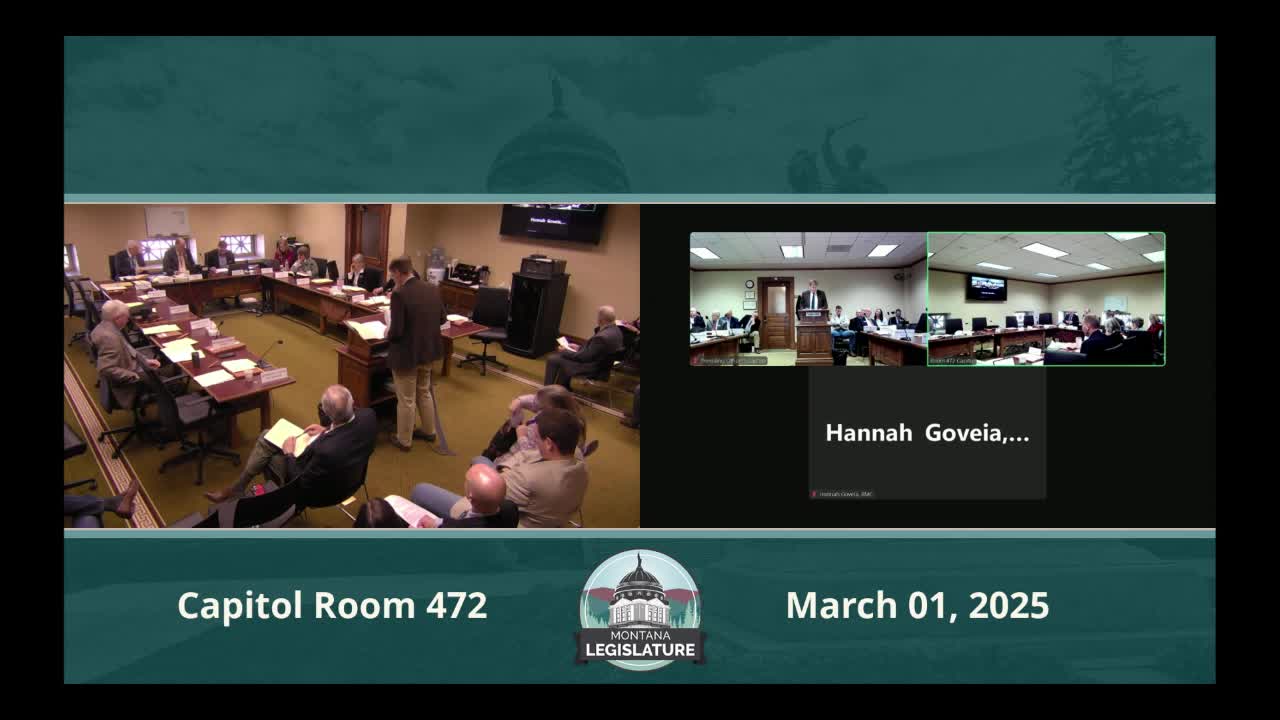Montana bill allows nutrient offsets to enhance water quality management
March 01, 2025 | 2025 Legislature MT, Montana
This article was created by AI summarizing key points discussed. AI makes mistakes, so for full details and context, please refer to the video of the full meeting. Please report any errors so we can fix them. Report an error »

In a recent meeting of the Montana House Natural Resources Committee, lawmakers discussed House Bill 736, a significant revision to the state's Water Quality Act aimed at addressing nutrient pollution in watersheds. The bill proposes a system of nutrient offloading offsets, allowing dischargers to compensate for their nutrient outputs by funding or implementing pollution reduction projects within the same watershed. This approach is designed to create a net decrease in nutrient loading, which is crucial for improving water quality across Montana.
The bill's proponents, including representatives from the Montana Mining Association and the Montana Coal Council, emphasized its potential to provide flexibility and cost-effective solutions for industries while maintaining environmental standards. They argued that traditional wastewater treatment upgrades can be prohibitively expensive, often costing municipalities tens of millions of dollars without guaranteeing significant improvements in water quality. Instead, the proposed offsets would enable regulated point source dischargers to collaborate with local communities and agricultural producers on projects like riparian fencing, wetland development, and septic system removal, which could yield better environmental outcomes at a fraction of the cost.
Municipal representatives, such as Ed Coleman from Helena, echoed these sentiments, highlighting the need for practical solutions that address the complexities of nutrient pollution. Coleman pointed out that municipalities are committed to protecting water quality and are actively seeking ways to reduce nutrient outputs without incurring exorbitant costs. He noted that the bill would provide additional tools to help local governments manage nutrient pollution more effectively.
However, the bill is not without its critics. Environmental advocates raised concerns about the lack of robust monitoring and verification procedures to ensure that the proposed offsets genuinely lead to improvements in water quality. They stressed the importance of maintaining numeric standards for nutrient discharges and called for amendments to strengthen the bill's provisions.
The Department of Environmental Quality (DEQ) expressed support for the bill's concepts but acknowledged the need for further refinement of its language. DEQ officials indicated their willingness to collaborate with proponents to enhance the bill's effectiveness and ensure it aligns with existing environmental regulations.
As discussions continue, the committee will need to balance the interests of various stakeholders, including industry representatives, environmental advocates, and local governments, to craft a bill that effectively addresses nutrient pollution while promoting economic viability. The outcome of this legislation could have lasting implications for water quality management in Montana, making it a critical issue for both the environment and the state's economy.
The bill's proponents, including representatives from the Montana Mining Association and the Montana Coal Council, emphasized its potential to provide flexibility and cost-effective solutions for industries while maintaining environmental standards. They argued that traditional wastewater treatment upgrades can be prohibitively expensive, often costing municipalities tens of millions of dollars without guaranteeing significant improvements in water quality. Instead, the proposed offsets would enable regulated point source dischargers to collaborate with local communities and agricultural producers on projects like riparian fencing, wetland development, and septic system removal, which could yield better environmental outcomes at a fraction of the cost.
Municipal representatives, such as Ed Coleman from Helena, echoed these sentiments, highlighting the need for practical solutions that address the complexities of nutrient pollution. Coleman pointed out that municipalities are committed to protecting water quality and are actively seeking ways to reduce nutrient outputs without incurring exorbitant costs. He noted that the bill would provide additional tools to help local governments manage nutrient pollution more effectively.
However, the bill is not without its critics. Environmental advocates raised concerns about the lack of robust monitoring and verification procedures to ensure that the proposed offsets genuinely lead to improvements in water quality. They stressed the importance of maintaining numeric standards for nutrient discharges and called for amendments to strengthen the bill's provisions.
The Department of Environmental Quality (DEQ) expressed support for the bill's concepts but acknowledged the need for further refinement of its language. DEQ officials indicated their willingness to collaborate with proponents to enhance the bill's effectiveness and ensure it aligns with existing environmental regulations.
As discussions continue, the committee will need to balance the interests of various stakeholders, including industry representatives, environmental advocates, and local governments, to craft a bill that effectively addresses nutrient pollution while promoting economic viability. The outcome of this legislation could have lasting implications for water quality management in Montana, making it a critical issue for both the environment and the state's economy.
View full meeting
This article is based on a recent meeting—watch the full video and explore the complete transcript for deeper insights into the discussion.
View full meeting
